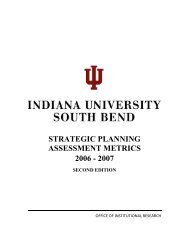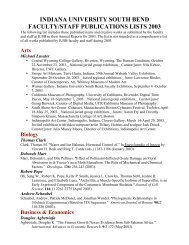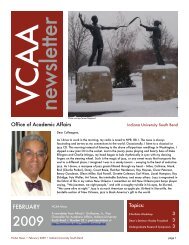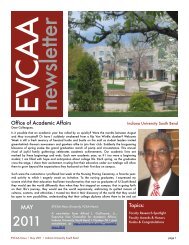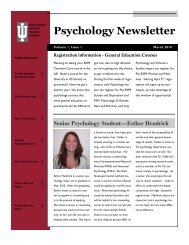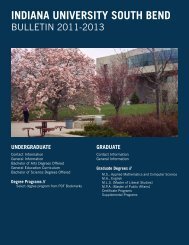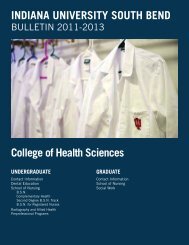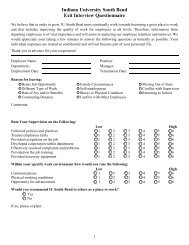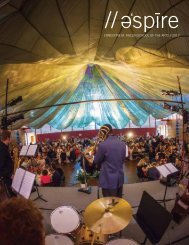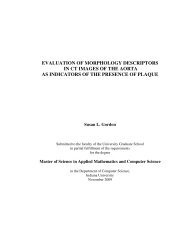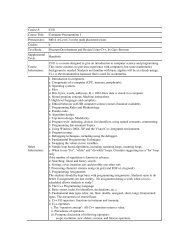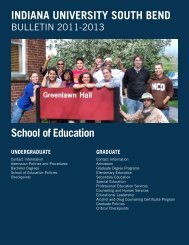Current version - Indiana University South Bend
Current version - Indiana University South Bend
Current version - Indiana University South Bend
Create successful ePaper yourself
Turn your PDF publications into a flip-book with our unique Google optimized e-Paper software.
IU SOUTH BEND COURSE DESCRIPTIONS 4377<br />
PHSL-P 204<br />
Elementary Human Physiology (3-5 cr.)<br />
P: ANAT-A 210. R: One college-level<br />
biology course; one college-level<br />
chemistry course or one year high school<br />
chemistry. Lectures on blood, circulation,<br />
respiration, digestion, metabolism,<br />
excretion, endocrine system, muscle,<br />
nervous system, and special senses. For<br />
dental hygiene majors; credit not allowed<br />
toward a biology major. II<br />
PHSL-P 261 Human Anatomy and Physiology 1<br />
(4-5 cr.)<br />
P: BIOL-L 102, CHEM-C 102, or PHSL-P<br />
130. Introduction to basic structure and<br />
function of the human body including<br />
laboratory studies in gross anatomy,<br />
histology, and physiology. Topics are<br />
cellular anatomy and physiology, body<br />
tissues and integument, and the skeletal,<br />
muscle, endocrine, and nervous systems.<br />
Credit not allowed toward a biology<br />
major. I, II<br />
PHSL-P 262 Human Anatomy and Physiology 2<br />
(4-5 cr.)<br />
P: PHSL-P 261. The continuation of<br />
PHSL-P 261. Topics are the circulatory,<br />
respiratory, urinary, digestive, and<br />
reproductive systems; fluid and electrolyte<br />
balance; and acid-base balance. II, S<br />
PHYS: Physics<br />
PHYS-N 190<br />
PHYS-P 201<br />
PHYS-P 202<br />
The natural world (3-5 cr.)<br />
Introduces students to the methods<br />
and logic of science, and helps them<br />
understand the importance of science to<br />
the development of civilization and the<br />
contemporary world. Provides a context<br />
within which to evaluate the important<br />
scientific and technological issues<br />
of modern society. Interdisciplinary<br />
elements. I, II<br />
General Physics I (3-5 cr.)<br />
P: MATH-M 115 or equivalent. First<br />
semester of a two-semester, algebrabased,<br />
sequence. Newtonian mechanics,<br />
wave motion, heat and thermodynamics.<br />
Application of physical principles to<br />
related scientific disciplines including life<br />
sciences. Lectures, one hour recitation,<br />
and one two-hour laboratory each week.<br />
Credit not given for both PHYS-P 201 and<br />
PHYS-P 221. S<br />
General Physics 2 (3-5 cr.)<br />
P: PHYS-P 201. Second semester of a<br />
two-semester algebra-based sequence.<br />
Electricity, magnetism, light, and an<br />
PHYS-P 221<br />
PHYS-P 222<br />
PHYS-P 281<br />
PHYS-P 303<br />
PHYS-P 309<br />
PHYS-P 321<br />
introduction to the concepts of relativity,<br />
quantum theory, and atomic and nuclear<br />
physics. Lectures, one hour recitation,<br />
and one two-hour laboratory each week.<br />
Credit not given for both PHYS-P 202 and<br />
PHYS-P 222. S<br />
Physics 1 (3-5 cr.)<br />
C: MATH-M 215. First semester of a<br />
calculus-based sequence. Newtonian<br />
mechanics, oscillations and waves, fluids,<br />
heat and thermodynamics. Lectures,<br />
one hour recitation, and one two-hour<br />
laboratory each week. Credit not given for<br />
both PHYS-P 201 and PHYS-P 221. I, II<br />
Physics 2 (3-5 cr.)<br />
P: PHYS-P 221. C: MATH-M 216. Second<br />
semester of a calculus-based sequence.<br />
Electricity, magnetism, DC and AC<br />
circuits, light, geometrical and physical<br />
optics, and introduction to modern<br />
physics. Lectures, one hour recitation,<br />
and one two-hour laboratory each week.<br />
Credit not given for both PHYS-P 202 and<br />
PHYS-P 222. I, II<br />
Solid State Electronics I (3 cr.)<br />
Digital Electronics (1-4 cr.)<br />
P: MATH-M 115 or equivalent.<br />
Integrated lecture and laboratory course.<br />
Semiconductor devices; operational<br />
amplifiers; oscillators; Boolean Algebra;<br />
and digital circuits containing devices<br />
such as decoders, multiplexers, lightemitting<br />
displays, flip-flops, counters,<br />
registers, and memories. I, II<br />
Modern Physics Laboratory (2-3 cr.)<br />
P: MATH-M 216, PHYS-P 222.<br />
Fundamental experiments in<br />
mechanics, electricity and magnetism,<br />
thermodynamics, optics, and modern<br />
physics. Emphasis is placed upon<br />
developing basic laboratory skills and<br />
data analysis techniques, including<br />
computer reduction and analysis of data.<br />
II (even years)<br />
techniques of theoretical physics<br />
(3 cr.)<br />
P: MATH-M 216, PHYS-P 222.<br />
Introduction to the mathematical<br />
methods required for the general<br />
equations of theoretical physics with an<br />
emphasis on special functions, group<br />
theoretic techniques, integral transforms,<br />
and partial differential equations.



